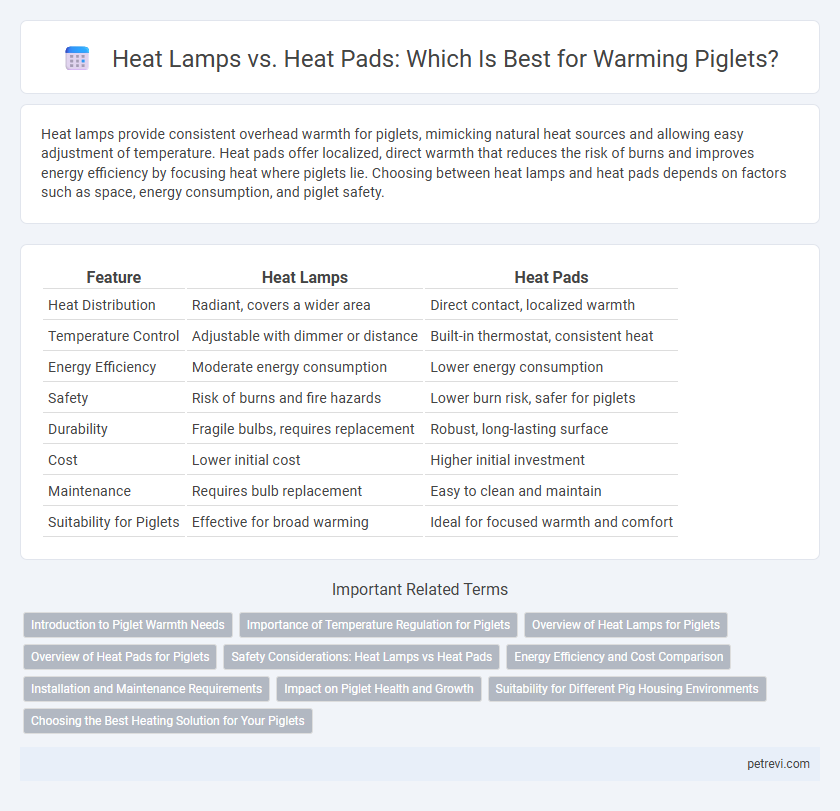Heat lamps provide consistent overhead warmth for piglets, mimicking natural heat sources and allowing easy adjustment of temperature. Heat pads offer localized, direct warmth that reduces the risk of burns and improves energy efficiency by focusing heat where piglets lie. Choosing between heat lamps and heat pads depends on factors such as space, energy consumption, and piglet safety.
Table of Comparison
| Feature | Heat Lamps | Heat Pads |
|---|---|---|
| Heat Distribution | Radiant, covers a wider area | Direct contact, localized warmth |
| Temperature Control | Adjustable with dimmer or distance | Built-in thermostat, consistent heat |
| Energy Efficiency | Moderate energy consumption | Lower energy consumption |
| Safety | Risk of burns and fire hazards | Lower burn risk, safer for piglets |
| Durability | Fragile bulbs, requires replacement | Robust, long-lasting surface |
| Cost | Lower initial cost | Higher initial investment |
| Maintenance | Requires bulb replacement | Easy to clean and maintain |
| Suitability for Piglets | Effective for broad warming | Ideal for focused warmth and comfort |
Introduction to Piglet Warmth Needs
Piglets require a stable and warm environment immediately after birth due to their limited ability to regulate body temperature and high susceptibility to hypothermia. Heat lamps provide radiant warmth, which can cover a broader area and help simulate natural sunlight, creating a comfortable temperature gradient. Heat pads offer direct, consistent contact heat, reducing energy expenditure for piglets but require careful management to avoid overheating or uneven heat distribution.
Importance of Temperature Regulation for Piglets
Heat lamps provide consistent radiant heat ideal for maintaining piglet body temperature, essential for preventing hypothermia during their early life stages. Heat pads offer a safer, energy-efficient alternative by delivering even warmth at low temperatures, reducing the risk of burns and overheating. Proper temperature regulation supports piglet immune function, growth rates, and overall survival, making the choice between heat lamps and pads critical for optimal swine husbandry.
Overview of Heat Lamps for Piglets
Heat lamps provide radiant heat that mimics natural warmth, making them a popular choice for piglet care. They offer adjustable temperature control and can cover a broad area, which helps maintain consistent warmth essential for piglet growth and health. Proper installation and regular monitoring ensure safety and prevent overheating, reducing risks of fire and skin burns.
Overview of Heat Pads for Piglets
Heat pads provide consistent, energy-efficient warmth ideal for maintaining piglet body temperature during critical early life stages. Their surface design mimics the sow's natural warmth, reducing piglet stress and promoting better rest and growth. Unlike heat lamps, heat pads minimize risks of overheating and fire hazards, making them a safer option in farrowing environments.
Safety Considerations: Heat Lamps vs Heat Pads
Heat pads provide consistent, localized warmth with lower fire risk compared to heat lamps, which can pose hazards if improperly installed or maintained. Heat lamps may cause overheating or burns due to direct exposure, while heat pads generally have built-in temperature controls to prevent piglet injury. Choosing heat pads enhances piglet safety by minimizing fire risks and ensuring steady heat delivery in farrowing environments.
Energy Efficiency and Cost Comparison
Heat pads for piglet warmth offer higher energy efficiency by providing consistent, targeted heat with lower wattage, reducing electricity consumption compared to heat lamps. Heat lamps consume more energy due to radiant heat dispersal and increased heat loss, leading to higher operational costs over time. Cost comparison shows heat pads require a higher initial investment but yield long-term savings through reduced energy bills and longer product lifespan, making them more economical for sustainable piglet care.
Installation and Maintenance Requirements
Heat lamps for piglet warmth require secure mounting and regular bulb replacement to prevent overheating and fire risks, while heat pads involve simple placement and periodic cleaning to maintain hygiene and consistent warmth. Installation of heat lamps demands stable fixtures and overhead power sources, whereas heat pads need accessible electrical outlets and flat surfaces for optimal contact. Maintenance of heat pads is generally easier, involving occasional sanitation, compared to the more frequent monitoring and bulb changes necessary for heat lamps.
Impact on Piglet Health and Growth
Heat lamps provide consistent and adjustable warmth that simulates a natural environment, reducing the risk of chilling and promoting steady piglet growth. Heat pads offer targeted, low-energy heating that helps maintain an optimal body temperature, enhancing piglet comfort and reducing mortality rates. Proper temperature management using either method supports immune function and accelerates early development in piglets.
Suitability for Different Pig Housing Environments
Heat lamps provide broad, adjustable warmth ideal for open or drafty pig housing environments where consistent heat distribution is needed. Heat pads offer targeted, energy-efficient warmth suited for enclosed or insulated farrowing crates, promoting direct contact heat and reducing the risk of overheating. Choosing between heat lamps and heat pads depends on the piglet housing design, ventilation, and the ability to maintain stable temperatures for optimal piglet comfort and health.
Choosing the Best Heating Solution for Your Piglets
Heat lamps provide a radiant heat source that mimics natural warmth, ideal for creating a controlled microclimate for piglets, while heat pads offer consistent, direct ground heat promoting comfort and energy efficiency. Evaluating factors such as energy consumption, risk of overheating, and ease of cleaning helps determine the best heating solution, as heat lamps may pose burn risks and higher electricity costs compared to heat pads. Selecting the appropriate heating method depends on piglet age, environmental conditions, and farm setup to ensure optimal growth, safety, and overall health.
Heat lamps vs Heat pads for Piglet warmth Infographic

 petrevi.com
petrevi.com